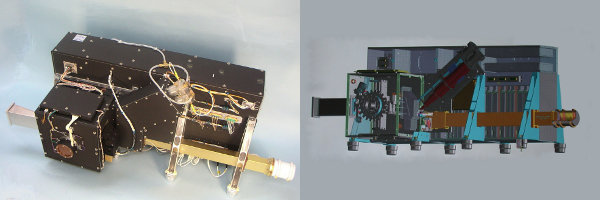
COSIMA - COmetary Secondary Ion Mass Analyzer
COSIMA is the in-situ dust analyzing instrument on the orbiter of ESA's corner stone mission Rosetta to comet 67P/Churyumov-Gerasimenko. It performs microanalysis of individual dust particles emitted by the comet and collected by the COSIMA dust collector.
The COSIMA instrument is a secondary ion mass spectrometer (SIMS) equipped with dust collectors, an ion gun, and an optical microscope for grain localization. SIMS is a sensitive method to analyze the composition of the surface layers of the tiny samples. It allows the characterization of the chemical composition in view of the organic and mineral components in a single measurement for a single grain.

Science objectives:
The main objective of COSIMA is to study the physical and chemical composition of the comet’s dust environment as well as processes that occur in, on, and near the cometary nucleus. In particular, COSIMA allows researchers to determine the composition of dust particles from different regions of the cometary nucleus, released at different activity periods, and to compare dust grain mineralogy, chemistry and composition. The main science objectives of COSIMA are:
- characterize the dust grains released from the nucleus of comet 67P/Churyumov-Gerasimenko
- determine the molecular, elemental and isotopic composition of grains
- monitor the dust for many months at various cometary activity levels
- study the mineralogy and chemistry of the cometary grains in the framework of the solar system chemistry
- assessment of the relevance of the cometary organic matter as potential precursor material for more complex organic matter
- evaluation of inorganic phases and mineral components in cometary matter as relevant to the early Earth's chemistry
The instrument:

The COSIMA instrument is a time-of-flight secondary ion mass spectrometer equipped with a dust collector, a primary ion gun, and an optical microscope (COSISCOPE) for target characterization. Once one of the targets has been exposed to cometary dust it is transferred to the focal plane of the microscope and imaged under shallow angle illumination provided by red light emitting diodes. On-board image evaluation detects the presence and location of dust particles with diameters exceeding about 20 micrometer and calculates their position relative to the target reference point. Once the presence of features of interest is established, the target is moved in front of the mass spectrometer. Nanosecond duration pulses of indium-115 with an energy of 8 keV and about 50 µm in diameter from the primary ion gun impact on the selected feature. Secondary ions from the cometary grains are extracted by an extraction lens into the TOF section.
After passing deflection plates for beam steering, the ions travel through a field free section. Next they pass a two stage reflector and return through the drift section to the single stage microsphere plate ion detector. The arrival time of each ion is measured with an accuracy of about 2 ns. Precision in the timing of the primary ion pulses, the correct selection of the dimensions and the voltages of the mass spectrometer and the accurate measurement of the secondary ion flight time are mandatory perquisites to obtain the high mass resolution in the COSIMA instrument (about 1500 at 100 amu). Eventually, all these mass spectra collected and stored from the various dust grains are transmitted by Rosetta to Earth.

Operations:
The instrument was be re-commissioned in April and July 2014, and operated next to the comet nucleus from August 2014 to September 2016. It collected more than 20.000 mass spectra of more than 30.000 particles and particle fragments in the science phase of Rosetta at comet 67P/Churyumov-Gerasimenko.
The Team:
COSIMA was built by a consortium led by the Max-Planck-Institut für Extraterrestrische Physik (Garching, Germany) in collaboration with Laboratoire de Physique et Chimie de l'Environnement et de l'Espace, CNRS / Université d’Orléans (France), Institut d'Astrophysique Spatiale, CNRS / Université Paris Sud (Orsay, France), Finnish Meteorological Institute (Helsinki, Finland), Universität Wuppertal (Wuppertal, Germany), von Hoerner und Sulger GmbH (Schwetzingen, Germany), Universität der Bundeswehr (Neubiberg, Germany), Institut für Physik, Forschungszentrum Seibersdorf (Seibersdorf, Austria), Institut für Weltraumforschung, Österreichische Akademie der Wissenschaften (Graz, Austria) and is lead by the Max-Planck-Institut für Sonnensystemforschung (Göttingen, Germany).
The support of the national funding agencies of Germany (DLR), France (CNES), Austria, Finland and the ESA Technical Directorate is gratefully acknowledged.
We thank the Rosetta Science Ground Segment at ESAC, the Rosetta Mission Operations Centre at ESOC and the Rosetta Project at ESTEC for their outstanding work enabling the science return of the Rosetta Mission.


